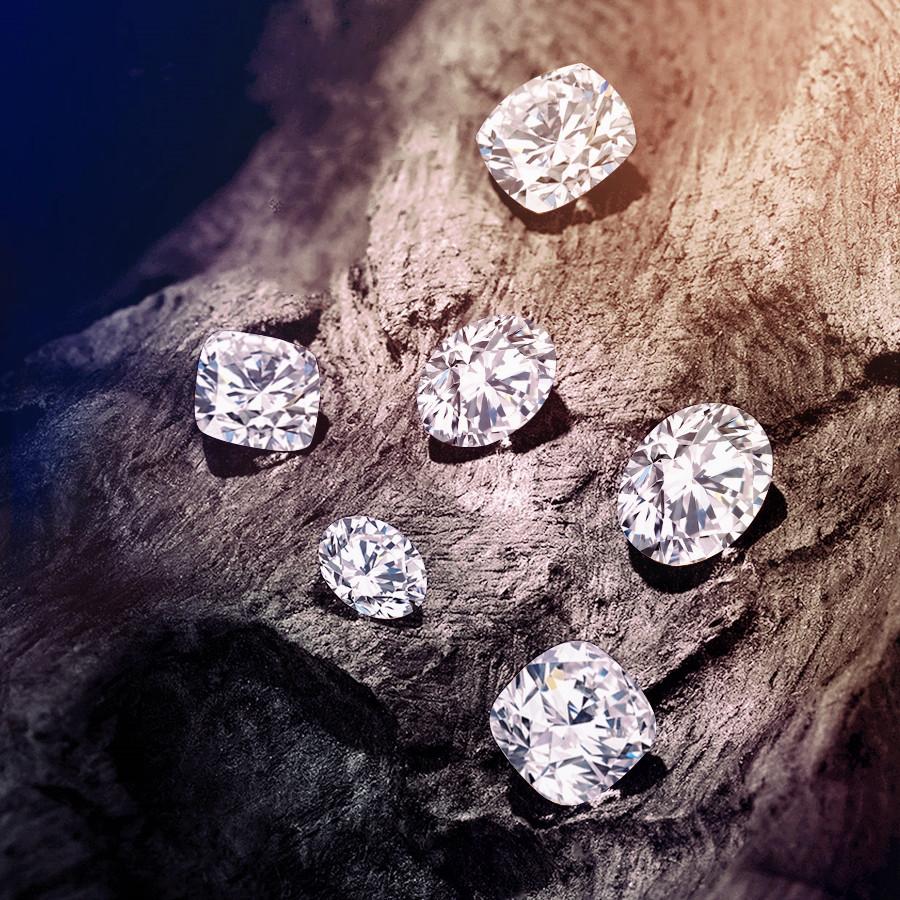Your Cart is Empty
All OUR RING CAN PASS THE DIAMOND TESTER

What is Diamond
Diamond. The rough stone is diamond. It is a simple crystal composed of carbon element formed under high pressure and high temperature in the deep earth. After strict screening, only about 5% of diamonds have been polished and cut into gem-quality diamonds.
Diamond characteristics
Diamond has a hardness of 10, which is the hardest mineral known in nature. At the same time, it is also very brittle and should not be impacted. Diamonds are lipophilic and hydrophobic. They will have no trace when exposed to water, and will be lingering when exposed to oil. The reason why they don’t flash after wearing for a long time is because they are stained with human oils. Diamonds have high thermal conductivity, breathe into natural diamonds, and the water mist on the diamond surface will evaporate significantly faster than similar substances. Using a pencil to draw on the diamond does not leave a mark.
Diamond origin
The top five producing countries: Australia, Zaire, Botswana, Russia, South Africa, accounting for 90% of the world's total production
Top 30 producing countries: Congo (Kinshasa), Brazil, Guyana, Venezuela, Angola, Central Africa, Ghana, Guinea, Ivory Coast, Liberia, Namibia, Sierra Leone, Tanzania, Zimbabwe, Indonesia, India, China, Canada
India: the country where diamonds were first discovered
South Africa: The diamond particles are large, and the output and output value have long been in the forefront of the world. The largest diamond ever produced: Cullinan Diamond
Australia: the country with the largest diamond production, the country with the largest production of pink diamonds and the best quality
Botswana: the country with the largest diamond production
Diamond reserves
The proven diamond reserves are about 2.5 billion carats, of which 650 million carats in Australia and 550 million carats in Zaire. According to the mining level, the existing diamond reserves can only be mined for 25 years. Although new mines are discovered every year, due to the difficulty of mining and the small proportion of gem-grade diamonds, there will be fewer and fewer high-quality natural diamonds.
So, how to measure the quality of a diamond
There are mainly 4 dimensions: the 4C standard, which was created by GIA (Gemological Institute of America), and is universal
Diamond weight: CARAT
Diamonds are measured in carats, the internationally accepted weight unit. The symbol is ct. 1 carat is divided into 100 points, and the total weight is 0.2 grams.
1ct = 0.2g = 100 points 1 point = 0.01ct
Color:
Take white diamonds as an example (colorless diamonds). The top color is D color, which is arranged down to Z. The closer the color is to D color, the better the color and the higher the corresponding price. Simply divide it.
D E F: Colorless diamonds are high-quality diamonds
G H: Spokenly called white diamonds, they are medium to high-quality diamonds. They are highly recommended for customers with limited budgets and certain requirements.
I J: Cost-effective diamonds are common in polished diamonds in shopping malls. For example, 70% of the psychic jewelry counters are of this color level (the psychic internal staff told me)
K L M: It is often used to package and sell special diamonds. The yellow color is visible to the naked eye, which affects the fire color and has poor visual perception. It is not recommended
N-Z: It is a junk color, will not be sold on the counter, and has no value
Clarity:
Quality from high to low:
FL IF VVS1 VVS2 VS1 VS2 SI1 SI2 SI3 P1 P2 P3
Roughly divide the five major LC (FL, IF) VVS VS SI I (P), common in retail stores
Carefully observe the cleanliness of the diamond under a ten times microscope. The more flaws and the more obvious the location, the worse the quality and the corresponding lower price.
LC grade means no flaws can be seen under the ten times lens
VVS is very difficult to see flaws under a tenx lens
VS is difficult to see flaws under a tenx lens
SI can see flaws under a tenx lens
Generally, LC grade diamonds rarely appear in the retail market. When the clarity is SI2, the probability of visible flaws is extremely high. Therefore, when recommending to customers, try to recommend diamonds above SI1 and above one carat to have a clarity distribution diagram. Try to avoid blemishes that are obvious on the table, and diamonds with larger blemishes.
Cut:
Standard round diamonds have 57 or 58 facets. The quality of the cut directly affects the sparkle of the diamond. The cut can affect 40% of the diamond price. The international standard uses three dimensions: cutting, polishing, and symmetry to measure the quality of the cut.
Each dimension has five levels, from high to low:
EXCELLENT: perfect
VERY GOOD: Very good
GOOD: Good
FAIR: General
POOR: very bad
Read More:
Simple Identification Method For Diamonds
https://www.supskart.com/blogs/news/simple-identification-method-for-diamonds